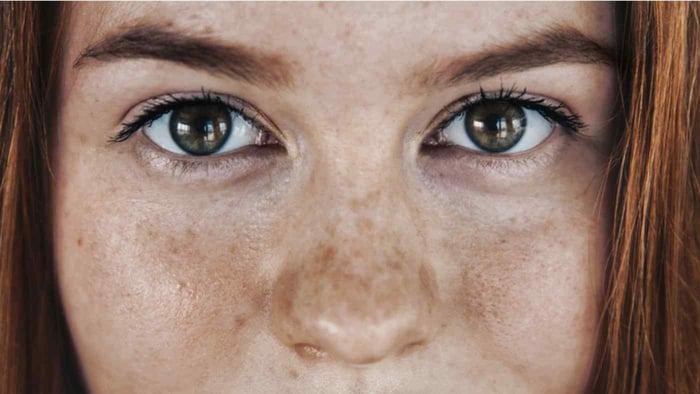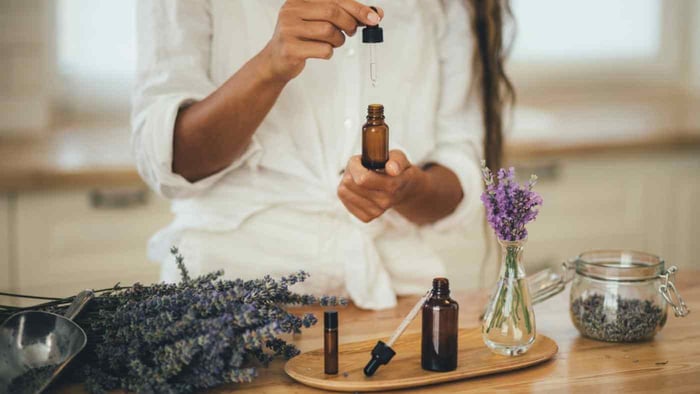Crepey skin can seem like an ongoing battle.
With each passing year, our skin becomes thinner and less taut.
We’ve all noticed those areas where skin appears paper thin, almost like tissue paper, and starts to resemble the thin, crinkled crepe paper of party streamers.

What is Crepey Skin?
Crepey skin is just that—damaged skin that has started to resemble crepe paper—that thin, party streamer paper that appears to have been crumpled up tightly, then unrolled.
Crepey skin tends to sag or hang loose, and looks and feels much thinner than the skin on other areas of your body.
While the sun is one of the major contributors to thinning and crepey skin, it isn’t the only one.
Read on to discover other causes of crepey skin and what you can do about it.
What Causes Crepey Skin?
Sun damage is the most common (and preventable) cause of crepey skin, and that should be reason enough to never leave home without your SPF.
But other factors also contribute to the loss of our skin’s elasticity as well.
- Aging. As we age, our bodies produce less collagen and elastin (the fibers that make our skin look smooth and supple), and that contributes to looser, less taut, sagging skin.
- Pollution. Environmental factors, like air quality, can also have an impact on your skin. Pollutants like particulate matter, ozone, and airborne chemicals can all cause premature aging of the skin, including pigment spots and wrinkles.
- Smoking. Not good for your body, not good for your skin. Smoking is a sure way to damage your skin. The free radicals generated by smoking damage your skin’s ability to repair itself, which leads to premature aging. Smoking also creates more facial lines, under eye puffiness and hollowing out of the eyes, along with reduced fullness and lines around the lips.
- Heavy alcohol consumption. Excessive alcohol consumption (defined as eight or more drinks per week in this study) damages the skin’s antioxidant defense system. Excessive drinking causes facial redness and broken capillaries, and leads to premature aging of the skin.
- Dehydration. Lack of moisture in your body, will lead to dehydration in your skin. When your body isn’t properly hydrated, it will sap moisture from your skin. Drink plenty of water and curb your cocktails, as alcohol is dehydrating.
- Sun. Over time, the ultraviolet rays from the sun and tanning beds break down the skin’s elasticity, and damage its ability to repair itself and bounce back. The UV rays also damage the skin’s cells, making it more difficult for them to retain moisture. That leads to thinner, less elastic, looser skin.
- Weight loss/gain. Carrying extra weight around stretches out the skin and damages its elasticity. If someone loses or gains a lot of weight quickly, that can leave them with loose, hanging skin after it can no longer snap back.
- Medication. The long-term use of certain medications can also damage the skin. Topical and oral steroids like prednisone, prescription blood thinners, and over-the-counter medications like aspirin and nonsteroidal anti-inflammatory drugs (NSAIDs), like ibuprofen (Advil) or naproxen (Aleve) are known to cause damage to the skin and their use over a long period of time can lead to thin, crepey skin.
- Stress. Increased cortisol levels, which is the hormone the body produces when stressed, is also linked to skin damage. Exposure to chronic stress suppresses the body’s immune response, exacerbates some allergic and inflammatory diseases, and makes the body more susceptible to infection.
Where Does Crepey Skin Develop?
Crepey skin is most likely to develop on certain areas of the body where the skin is already the thinnest.
Areas like under the eyes, the inner upper arms, under the chin, the neck, abdomen, and inner thighs are all more susceptible to developing crepey skin.
How to Treat Crepey Skin
The good news is, certain treatments can improve the appearance of crepey skin, from at-home options to professional treatments by licensed practitioners.
Here are some ways you can improve the look of crepey skin.
Professional Treatment for Crepey Skin

- Fractional laser treatments. Lasers are used to heat up targeted areas of the skin to stimulate the production of collagen and elastin and help jump-start cell turnover.
- Ultrasound. This treatment uses targeted ultrasound heat waves, which also stimulate collagen production and help tighten skin.
- Radiofrequency. These waves firm and tighten skin and improve laxity.
- Dermal fillers. Certain types of dermal fillers can be effective in treating crepey skin by adding fullness to the area to fill out wrinkles and stimulating collagen production.
- Retinoids. Available in both OTC and by prescription, retinoid gels and creams can help aid cell turnover. But keep in mind the drying nature of these, and use carefully and in conjunction with a good moisturizer.
At Home Treatment for Crepey Skin

Red Light Therapy
Already medically in use to treat some skin conditions, like skin cancer, psoriasis, acne and warts, research shows that low wavelength red light therapy is also effective at reducing fine lines, wrinkles and age spots, and improving the look of your skin.
The treatment uses low level red light to stimulate the mitochondria in your skin cells, which helps them produce more energy, which in turn helps them rejuvenate more quickly—giving you smoother, healthier looking skin.
There are devices you can purchase for at-home use, or schedule a professional treatment with a licensed dermatologist.
Skin Tightening Creams
- With thousands of positive reviews on Amazon, Crépe Erase for body and face are proven winners when it comes to improving the look of crepey skin with regular use.
- For the more budget-conscious, Neutragena’s Hydro Boost body gel cream with hyaluronic acid gets high marks for its non-greasy, moisturizing.
- With more than 70,000 five-star reviews, CeraVe Daily Moisturizing lotion is one of the best lotions for crepey skin on the arms and legs.
How to Prevent Crepey Skin
The best treatment for crepey skin is prevention. But if you already see signs of it, there is still plenty you can do to prevent it from getting worse.
- Cover up with SPF. Not enough can be said about protecting your skin from the sun’s damaging rays. You can’t hide from it, so before you head outside, slather on a sunscreen that contains titanium dioxide, zinc oxide or both, and has at least an SPF 30. Grab a hat and wear other sun-protective clothing when spending extended time outside.
- Stay hydrated. Often when your body is thirsty, you are already on your way to being dehydrated. Hydration starts from the inside out, so drink plenty of H20 to help keep your skin supple.
- Moisturize. Don’t leave your skin high and dry! Slather on a good quality body and facial moisturizer daily. After a bath or shower is a great time! Keeping your skin well moisturized will help it from drying out and becoming crepey. Look for products that contain hyaluronic acid.
- Take collagen supplements. Lots can be said about the many health benefits of taking collagen supplements. This study in particular shows that participants who took collagen supplements showed significant improvement in skin hydration and wrinkles over those who didn’t.
Now that you know the causes of crepey skin and what you can do to prevent it, you can take good care of your epidermis!
Slather on the moisturizer and SPF, grab a hat, stay hydrated, and don’t add to the environmental stressors that damage your skin by smoking or overindulging in alcoholic beverages.
Protect your body’s largest organ and help keep it in tip top shape as you age!




